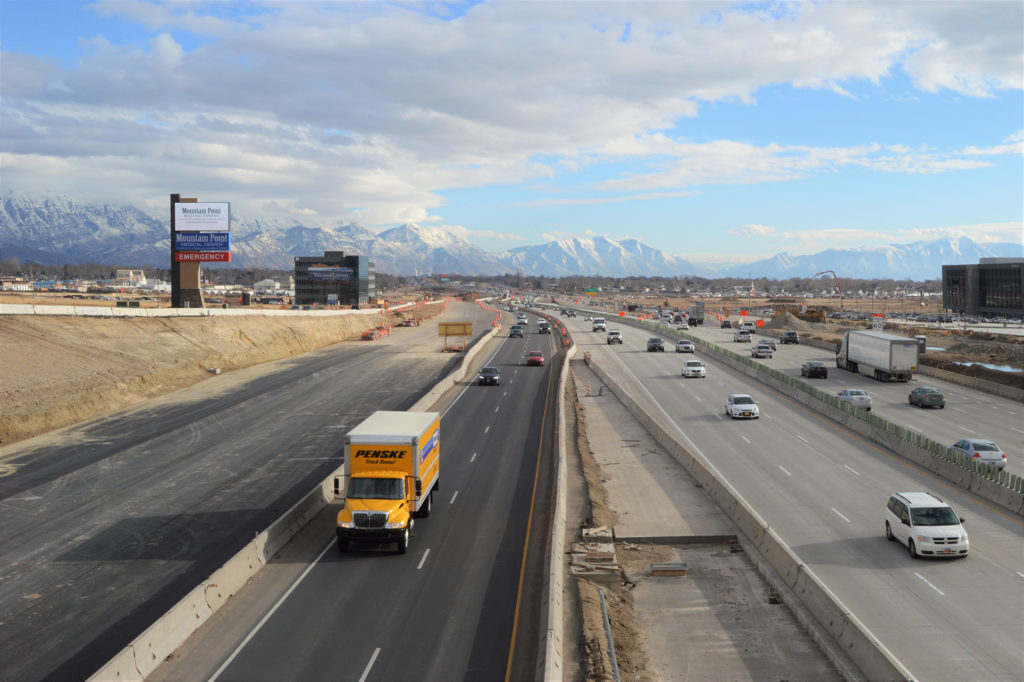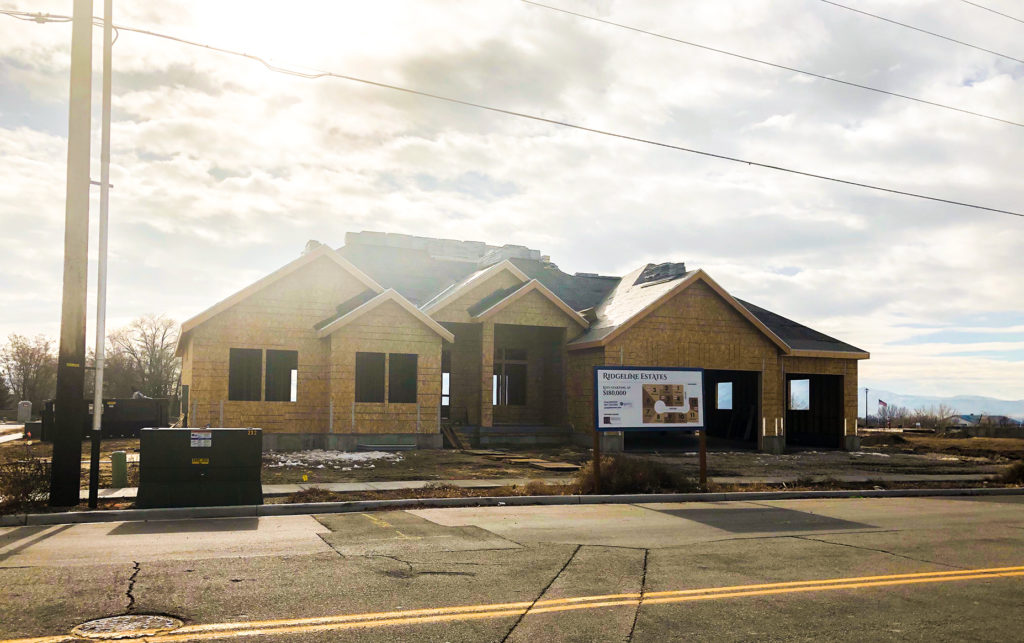Education
Top stories of 2018
Published
5 years agoon

The Lehi Free Press editorial board and leaders in our community were polled over the last several weeks regarding the top news stories in Lehi over the past year. This week’s issue of the Lehi Free Press highlights the top ten stories as we review 2018.
1. Technology Corridor construction well underway
Nicole Kunze
On April 25, 2018, Governor Gary R. Herbert piloted a drone for a pre-construction site tour of the Technology Corridor on I-15 in Lehi from the seventh-floor balcony of the UCCU Building on Digital Drive. Utah Department of Transportation (UDOT) Executive Director Carlos Braceras and Governor Herbert revealed a large-scale artistic rendering of the Triumph Blvd Bridge during the tour. The Triumph Bridge opened at the end of November, providing a new view of Lehi and convenient access between east and west Lehi over I-15.
“This is the biggest project we have going on right now across the entire state. This is the last piece of a project we envisioned many years ago. The project is about $430 million total. It’s going to make the final connection between Salt Lake County and Utah County,” said Carlos Braceras on April 25.
Governor Herbert piloted a drone on the balcony at UCCU while Bob Westover, UDOT Project Manager for the Technology Corridor, explained some of the features of the project during that site tour in Spring. “Instead of four lanes, there will be five lanes along the construction area during peak hours,” said Westover.
Giant construction cranes, mounds of earth, and heavy equipment are now a common site along the I-15 freeway in Lehi. The construction zone features uneven roadway and lane shifts, causing dozens of fender benders and traffic delays each week. There is a 60 MPH speed limit along the construction zone causing UDOT and the Utah Highway Patrol to urge motorists to slow down and be alert.
The freeway entrance at 2100 North has gone through the most upheaval during 2018 with the freeway entrance from the west side a diverging diamond where drivers are forced to turn south to enter the freeway going north and drive straight north in order to enter the freeway going south. For the most part, Lehi commuters have been patient with all the construction and changes, knowing that it will be worth all the inconvenience when the project is finished.
Part of the Technology Corridor project includes more pedestrian and bike trails, including connections to the Murdock trail over I-15 on the Triumph Bridge. The 500 East bridge over I-15 is also finished and open to vehicles.
2. Lehi growth continues through 2018
Heather Nielsen
Lehi is the state’s sixth oldest city and was founded by the Mormon pioneers back in 1852. Rich in pioneer and western history, the city was also known as Sulphur Springs, Snow Springs, Dry Creek, and Evansville. While the city was founded by hard-working pioneers, it’s been taking a new high-tech direction since the early 2000s. With a population of 19,028 in 2000, the city’s numbers more than doubled in 2010 reaching a population of 47,407 and continued to grow to a population estimated at over 65,000 today.
The word “growth” has been thrown around the city, bouncing off the walls of messenger boards, and floating throughout citizens’ chats, but what exactly does this “growth” mean? In 2016, the U.S. Census Bureau ranked Lehi as not only one of the fastest growing cities in the state, but the 11th fastest growing city in the country with a growth of 4.6%.
More and more people are moving to Lehi, estimated at up to 300 per month. The U.S. Postal Service in Lehi must continually revise postal routes to serve new neighborhoods. As tech businesses plant their roots in the city, more jobs are being created and more opportunities arise for residents of the city. If growth trends continue, Lehi’s population is estimated to reach nearly 85,000 by 2022.
Lehi’s growth can be attributed to many factors, but a huge part is due to the booming tech businesses arriving in Lehi. With Adobe, IM Flash, Xactware, Microsoft, Vivint, Oracle, and Xango headquartered in Lehi, the city is making a name for itself as a premier technology and commercial center.
“There’s a lot of talent and a good workforce here for these companies to hire and retain quality employees. So, primarily our economy, or this boom, anyway, has been driven by the tech sector, but, of course, you have retail and other industries that are following the population growth. So, year to year, we’re exploding at the seams. We’ve got thousands of housing units already in the pipeline ready to go, and we’re just trying to keep up with the infrastructure that those additional units will require.” Said Lehi City Administrator, Jason Walker.
3. Traverse Mountain development continues to be a headache for Lehi City
Possible health risks of mass grading continue to plague project
Donna Barnes
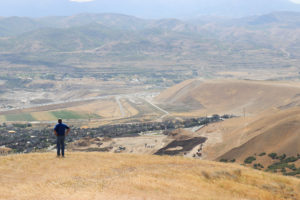
Mayor Mark Johnson contemplates Traverse Mountain development area, August 2018. | Courtesy Lehi City
On April 20th, 2017, TMTH, (Traverse Mountain Temporary Holding) a development group proposed a development above Greyhawk Drive in Traverse Mountain called the Traverse Mountain West Canyon concept plan to Lehi City Planning and Zoning Committee. The plan proposed high-density townhomes at the top of Fox Canyon.
Lehi City Council chambers were packed with residents from the area who mostly opposed the development. The major issue was the health impact of the grading operation required to build the project. Citizens opposing the plan complained that for almost 12 years Beck and Beck had been moving dirt in the area causing dust with potential health risks. Utah Physicians for a Healthy Environment gave a presentation explaining the health risks related to fugitive dust. Dr. Brian Moench, President of the group cited examples of pregnancy risks, asthma, bronchitis, ear infection, COPD, and even an incurable and debilitating disease called silicosis caused by a high concentration of silica in dust inhalation. The plan was approved with conditions in a split vote of two opposed to the plan and five in favor.
On June 27, 2017, the City Council approved the Traverse Mountain West Canyon concept plan which had undergone major changes since the April meeting. The high -density residential area would be relocated to an area just above US92. TMTH agreed to provide space for a church and a school. Kleinfelder, an engineering firm that deals with dust mitigation, had been hired to create a dust mitigation plan for the grading or “mining operation.” The plan was approved by the City Council.
Since many residents of the area were concerned about the health risks, Mayor Mark Johnson requested a study to be conducted by the Utah Department of Health Environment Epidemiology. Sam LeFevre presented the findings of the study to the City Council on August 28, 2018. LeFevre and his team concluded that the grading did not present a major health risk. “Auto exhaust was a greater risk that the grading,” commented LeFevre.
Since the report was given to Lehi City Council, Mayor Johnson received a letter from the Utah Department of Health containing troubling language creating a great deal of public comment. The paragraph from the letter reads, “In light of the uncertainty present in our quick and limited assessment, we strongly recommend that any decision for the Point of the Mountain relying on a health-based assessment be delayed until a more comprehensive assessment is completed.” This statement has created more heated debate about the health and safety of the impending development.
Recently, a request was made to Draper City by Geneva Rock to annex 70 acres of land in the area for materials acquisition. Draper City Council denied the request. Geneva Rock representatives said Lehi would be the loser in the denied annexation because part of the project was to reclaim some of the steep hillsides created by grading in the Traverse Mountain area.
Going into 2019, Lehi City staff and the City Council will continue to grapple with the problems associated with the TMTH project, the associated grading/mining, and the possible health risks.
4. Lehi loses $9.1 million in MAG money
Nicole Kunze
In August 2018 Lehi City engineers came close to getting final approval and funding for a road connecting Clubhouse Drive to 3600 West, but the objections of residents and the withdrawal of support by the owners Thanksgiving Point Golf Course derailed the project.
The Mountainland Association of Governments (MAG) is a committee made up of all the mayors in Utah County. They select and fund regional transportation projects for communities in the Provo/Orem urban area. Each year there is a Metropolitan Planning Organization (MPO) project selection process. City engineers must submit draft concepts that are due months before the vote takes place, and the drafts have to be approved by MAG’s engineers as well. The Clubhouse Drive/3600 West Road Connection proposed by Lehi City Engineers represented their solution to the critical roadway connection between the Thanksgiving Point area across the Jordan River going west. Phase one of the construction project proposed to extend a two-lane roadway from the intersection of Garden Drive and Clubhouse Drive, westward along the north side of the Thanksgiving Point Golf Course Clubhouse, then proceeding westward across the Jordan River, through the golf course and connecting to 3600 West.
According to the Project Summary Information submitted by Lehi City to MAG, the owners of the Thanksgiving Point Golf Course “are in support of exploring creative ways to provide alternatives for traffic on both sides of the river even though the concept plan will result in the extension of a roadway through their golf course.” Before the August 1 vote took place, however, representatives from the Thanksgiving Point Golf Course withdrew their support. In a letter to MAG and residents of Thanksgiving Village from Dave Harkness, President of Beesmark Investments, the family office of Alan and Karen Ashton, founders of Thanksgiving Point Institute, Harkness said, “Alan and Karen Ashton do not support the proposed Clubhouse Drive Extension Project. We believe other alternatives exist. The proposed road would divide the golf course and significantly impact the green space at Thanksgiving Point.”
Each member of MAG received a packet prior to the vote containing project summaries, maps, public input, and technical information and approvals. The Clubhouse Drive project came with more than two dozen handwritten letters from residents of Thanksgiving Village vehemently opposed to the new road. “We can make more roads, but if we lose the golf course, we will lose something that will be difficult to replace. We need Lehi to be recognized as a place where quality of life is important in order to attract quality residents. Don’t be short-sighted and ruin a championship golf course in order to build a road that will only bring more cars to an area that is way overcrowded to begin with,” wrote Judy Kilgore. “The Thanksgiving Point area is a special community. We treasure the beautiful green surroundings. We must leave a space for the Ashton Gardens and surrounding areas to continue to exist as it is. Please think creatively – we can solve this!” wrote Darlene and William Van Werkhoven.
“It didn’t seem like the Clubhouse Drive project had any support,” said one south county mayor of the final MAG vote. “I wanted to make sure my vote was going toward something that was wanted and needed, especially since it meant putting funding for projects closer to home on the back burner.” Since the Clubhouse Drive/3600 West Road Connection was voted down, the $9.1 million that would have gone to it was distributed among other construction projects in Utah County, including Spanish Fork Main Street improvements.
“We don’t have a backup concept for that east/west connection. It’s disappointing to get so close, to have the technical approval and the money that we needed, and to be back to square one,” said Kim Struthers, Community Development Director for Lehi City. While most residents of Thanksgiving Point were happy the plan for a Clubhouse Drive extension will not be executed, another resident of the area said, “This is a selfish move by Thanksgiving Point. We’ll continue to divert traffic through neighborhoods full of children and toward the busiest intersection in Lehi. This will come back to bite Thanksgiving Point as people decide to spend their free time in places with functional infrastructure.”
5. Mark Johnson takes helm as Lehi Mayor
Sally F. Francom
Nearly a year ago, In a brief ceremony on January 2, 2018 held at the Lehi City Council chambers, Mark I. Johnson was sworn in as the new mayor of Lehi City. Two re-elected City Council members, Paul Hancock and Christopher Condie also took the oath of office in January. Each spoke and expressed thanks to those who supported them in the recent election. Johnson addressed the attendees of the meeting, “to all the people here, I want to thank you for your support. We’ll continue to move forward to do great things in Lehi.”
In his first year as mayor, Johnson has encountered the challenges of leading a city still experiencing remarkable growth. The population of Lehi City is estimated to be over 65,000 residents. Commercial and residential development on the west and northwest side of Lehi continues at a steady pace. Farmland throughout Lehi is becoming increasingly rare.
The Lehi City Planning Commission continues to consider and send to City Council dozens of building project recommendations, adding developments at an unabated pace. Projects that have faced considerable public input and debate are the challenges surrounding mining/land removal in Traverse Mountain area, the future of development on the corner of Main Street and Center Street, now owned by real estate firm Parker Brown, and the ongoing challenges of farmers and ranchers as they continue operating in an increasingly suburban population center. Traffic issues, particularly in the Thanksgiving Point area continue to challenge the city.
In City Council meetings, Johnson places a high priority on City staff input. Johnson has reached out for evaluation and analysis from experts in matters that challenge the City. He is measured in his approach to issues and has asked the City Council to play a larger role in decisions, leadership responsibilities, and representing the City on various boards and committees.
According to Mayor Johnson, “There is a lot of talk about Lehi because our city is considered a major factor in the economic sustainability in our state. We have a crucial role to play regarding the entire Wasatch Front. Fortunately, we have a seat at every table involved in the planning process and we are evaluating potential demographics carefully. I have become convinced that we must approach growth and infrastructure issues head on and perform critical planning techniques now.” Johnson stressed that managing growth and addressing infrastructure needs continues to be the biggest challenge facing the city. Listening to citizen input, while balancing the infrastructure, housing, economic and safety requirements of a growing city is difficult, according to Johnson.
6. Traffic in northwest Lehi dangerous for school children and commuters
Nicole Kunze
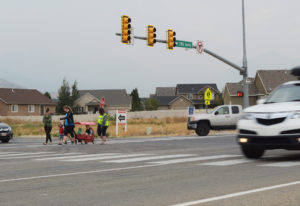
Crossing guard Tina Kemp helps mothers and their new kindergartners get across 2300 West and 2100 North safely. | Nicole Kunze
Many students attending Northpoint Elementary in northwest Lehi must walk to school from their homes in the Cranberry Farms and Point Meadows neighborhoods across 2100 North, which includes two lanes of fast-moving cars going west, and two lanes going east with a two-lane wide median in between, to get to school. Between the traffic on 2100 North and 2300 West where North Point Elementary is, just getting to school every day can be a dangerous challenge.
There are two crossing guards employed at the 2300 West crosswalk on 2100 North, one for westbound traffic and the other at the eastbound traffic light. “It’s just scary. The light makes it a little safer, but people still fly through it. Sometimes drivers speed up to catch the yellow light before it turns red. We try our best to get their license plates, but can’t always,” said crossing guard Tina Kemp. In their rush to get where they need to go, some drivers travel up to 60 miles per hour through the school zone when lights are flashing. The maximum legal speed limit in a school zone with lights flashing is 20 miles per hour.
Getting across 2300 West before and after school can also be a test for North Point Elementary students. Willowcreek Middle School is several blocks away on 2300 West, but that still means drivers are headed to work at Thanksgiving Point office buildings and two schools every morning, all on the same street. Lehi City has started installing a traffic light at the intersection of 2300 West and 1500 North to alleviate the traffic problem, but many parents and commuters aren’t convinced that will help.
When school started in the fall of 2018, parents of Northpoint Elementary students started a petition to the Utah Department of Transportation (UDOT) requesting consideration of building a pedestrian bridge across 2100 North. That idea is on hold, however, while Alpine School District (ASD) considers the boundaries for a new elementary school being built on the north side of 2100 North in the Holbrook Farms subdivision west of Thanksgiving Point. The ASD website says the new school will “help lower enrollment for schools in both Saratoga Springs and Lehi.”
In emotionally charged open houses for potential new boundaries in the area, parents have expressed new concerns about getting their children to school safely. For some current North Point Elementary students, a boundary change would mean they no longer have to cross busy 2100 North, but they would have to walk along it for more than a mile to get to school.
Northpoint Elementary students were taking buses across the busy highway, but the buses were discontinued in October 2011 upon initial completion of 2100 North when UDOT and Lehi City agreed to a slower speed limit and added crossing guards in the area. The state of Utah only funds buses for elementary students who live more than one and a half miles from their school. A parent on the UDOT petition pointed out that there are more cars on the road because people are driving their children to school now that a bus is no longer available, making the roads around the school even busier during the morning commute.
Boundaries for the new elementary school at Holbrook Farms will be announced in late January 2019.
7. Porter’s Place property development turns the spotlight on Main Street corner
Nicole Kunze
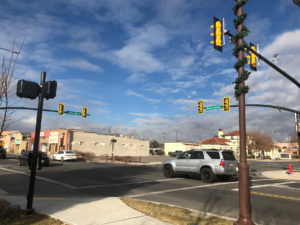
The busy intersection of Main Street and Center Street in downtown Lehi. Parker Brown is reworking a plan for a building on this corner. | Sally Francom
One year ago, the .21-acre property on the corner of Center Street and Main Street in Lehi was the home of long-time Lehi restaurant, Porter’s Place. Lehi City was leasing the building to Bob Trepanier, but sewer problems, among other issues, forced the City to consider the future of the century-old structure.
Lehi City began accepting Request of Proposal (RFP) bids for the Porter’s Place property in January 2018 and by February Trepanier had moved his restaurant to Eureka, Utah. Three RFP bids were submitted to Lehi City by the deadline and Brian Brown of Parker Brown Real Estate and partner Brian Knowlton of Knowlton General ended up with the Main Street property, which included two buildings and the parking lot next to it. In late Spring, Brian Brown said, “We love Lehi and the downtown area, and we are designing a brownstone-style building that will preserve the historic and hometown feel of downtown Main Street. We will be incorporating the old with the new and hope to reuse some of the building materials, including brick and other memorabilia from Porter’s Place. We want to build something the city will be proud of.”
In the November 8 Planning Commission meeting, Brian Brown brought forth three agenda items; a request to change the zoning for the Main Street property from Mixed Use to Historic Commerce, a request to change height restrictions of buildings in the Historic Commerce District from three stories to four stories, and he presented a concept plan for a new building that would replace Porter’s Place and the adjacent parking lot. Brown’s was the first request to use the Historic Commerce designation, although it has been available for the last six years.
The Planning Commission was unanimous in favor of Brown’s zone change request but increasing the building height was a sticking point for members of the Planning Commission and most residents who came to be heard during the public input portion of the meeting. Former longtime Planning Commission member Janys Hutchings said, “We need to address what we want Historic Commerce to look like, what kind of infrastructure needs to be in place. This is a very small piece in a vision that hasn’t been defined yet.”
Members of the Planning Commission were split in their vote regarding a change in height for buildings in the Historic Commerce District, so the request was sent to City Council without a recommendation. At the December 11 City Council meeting Mayor Johnson, members of the City Council, Brian Knowlton, Brian Brown, and several Lehi residents discussed Main Street and the four-story building concept Knowlton and Brown presented for more than an hour. When the City Council finally voted, they unanimously denied Knowlton and Brown’s request to change the building height to four stories in the Historic Commerce District.
Brian Brown is still excited to build on the old Porter’s Place property. “Downtown revitalizations are tough, people are emotionally connected to these places. History isn’t preserved in the brick and mortar, though, it’s in the people and the sense of community.” Knowlton and Brown are now going back to the drawing board to create a new concept for their building using suggestions from Mayor Johnson and the City Council.
During Planning Commission and City Council meetings regarding the Porter’s Place property, everyone could agree on one issue–parking along Main Street is not adequate. Council Member Johnny Revill said, “If our real goal is to revitalize downtown then we as a city need to take some of the responsibility to find new parking.”
Lehi City Planning and Zoning will unveil a new General Plan early in 2019 and that will include more specific details about the Historic Commerce District.
8. $8 billion acquisition of Utah tech company, Qualtrics, brings national and international attention to Silicon Slopes
Gina Halladay
Nationally and internationally what is happening in the business world of startups and technology communities at Silicon Slopes is getting noticed. Big time. “This has been an amazing 2018, according to Clint Betts, the executive director at Silicon Slopes, a non-profit organization based in Lehi. Investors, entrepreneurs, and companies from all over are seeing Utah as a world-class tech community. “There is no question that Utah is on their map.”
In a year-end review interview, Betts said, “how can they not notice what is happening in Utah”? “We had the largest buy of a tech company, ever, when Qualtrics was acquired by SAP for $8 billion,” said Betts. The acquisition was the largest venture capital-backed enterprise software acquisition in history–not just in Utah history–in tech world history.
“We are going to look back on this year, a decade from now, and see how amazing it really was,” said Betts. “There were so many milestones with the number of companies who have either gone public, had successful fundraising, or have been acquired including: Pluralsight, who went public with an initial public offering; Purple, who merged with another public company; DOMO, who also had an IPO; Teem, who was bought by WeWork for $100 million, and Weave who recently raised $37.5 million have all brought attention to Utah, said Betts.
“This startup and tech community is not going to be slowing down and will continue to build,” said Betts. “We are looking forward to seeing the next wave of companies that will soon have their moment to shine.”
“The whole world is listening and watching to what is happening with startups and tech companies in Utah. We have stepped onto the world stage. In the next few years, Utah will be known as the hub of all tech companies in the country,” predicts Betts. Silicon Slopes (siliconslopes.com) was started about four years ago and it’s founders include Betts, who is also the founder of Beehive Startups; Josh James, CEO at DOMO; Dave Elkington, InsideSales.com CEO and Aaron Skonnard, CEO at Pluralsight. The organization is headquartered in Lehi and has 13 different chapters from Logan to St. George.
With more than 6,500 startup and tech companies in Utah, Silicon Slopes has a mission to “empower Utah’s startup and tech community to learn, connect and serve in an effort to make entrepreneurship and opportunity in Silicon Slopes open and accessible to all.”
“We want to the world to learn about what is happening in Utah. We are a media company that tells the stories of startups and tech communities through social media, podcasts, and magazines,” said Betts. “We connect entrepreneurs by hosting over 200 events a year -that is almost one every business day. Our biggest event is our upcoming Tech Summit which is a globally recognized two-day summit which will be held Jan. 31 and Feb. 1 at the Salt Palace,” said Betts. 20,000 people are expected to attend.
“Our other mission, is to serve and give back,” said Betts. Silicon Slopes recently launched their “Silicon Slopes Serves” division which will facilitate all of the many service projects they support and sponsor. In 2019, they are partnering with Feeding Children Everywhere to provide one million meals to children by encouraging individuals and companies to donate money and/or time to pack and ship meals to starving children. “We are also passionate about improving education in Utah and fighting to improve childhood literacy by hosting book drives and have committed to work towards having computer science classes in every Utah school by 2022. We tend to get loud about the issues we care about,” said Betts.
“There are a lot of reasons why startups and tech communities are attracted to Utah,” said Betts. “We have three great universities nearby; Brigham Young University, University of Utah and Utah Valley University that provide a powerful workforce and new entrepreneurs. The state is also very business friendly with a Governor that is very supportive. Utah’s culture and beautiful outdoors is also a draw and we have a community that exists to support each other and the next generation of entrepreneurs.”
9. Skyridge Volleyball brings home first state championship
Donna Barnes

The entire Skyridge girls volleyball team, coaches, and staff after winning the championship. | Matt Paepke
A sea of orange flooded the bleachers at the Utah Community Credit Union Fieldhouse Saturday, November 3, as the Skyridge volleyball team fought back from a first set loss in the state championship match against Springville. Skyridge had defeated the Red Devils twice in regular season play. This State volleyball victory was a first for the new high school.
The 5-A tournament started Thursday evening, November 1 at the UCCU Center on the UVU campus. Skyridge waltzed through the first two games playing Farmington first and defeating them in three sets.
The second match of the tourney pitted Skyridge against Murray. Skyridge went up 19-6 after the first 15 minutes of play. Set scores were 25-12, 25-7, and 25-12. Skyridge looked unbeatable, and the Murray victory put the Falcons in the next round.
Saturday, November 3, the championship match was set as Springville defeated Corner Canyon and Skyridge defeated Box Elder. Many felt the championship game should have been between Box Elder and Skyridge as the two teams had traded rankings, either first or second, all season. Box Elder was last year’s 5A champions.
Championship Game: Skyridge vs Springville
The championship match was a spectacle as the lights were dimmed and the two teams paraded into the gymnasium. The National Anthem was sung by Skyridge student, Brooklyn Booth. The teams took the floor to the deafening roar of the cheering student sections. The Skyridge students were on their feet during the entire match.
During the first set, Springville’s athletic team took advantage of some service errors and errant hits. The Falcons seemed to be suffering from some jitters as the Red Devils jumped out to a 14-7 lead. Skyridge came back within 3, but the Falcons couldn’t prevail, and Springville won 25-19.
In the second set, Springville led during the first few minutes. It looked like this might be a re-run of the first set, but in the final minutes, with Lexie Greenwood serving dead on, Skyridge scored 5 straight points to tie the game at 24. The Falcons gained composure and did what they have done all season as they found a way to win, 26-24.
The final two sets saw the Skyridge girls gain back their confidence. Coach Deanna Meyer, whose demeanor is always controlled and positive, guided her team to wins, 25-20 and 25-10. Kenadee Christensen found her groove and made several key kills to invigorate the team. Sophomore Annie Taylor was also deadly as an outside hitter. Lexie Greenwood was steady in serving and other aspects of the game. Ken Greenwood, grandfather to three Skyridge players, commented at the end of the match, “That’s what a total effort looks like. Good stuff.”
Statistics tell the story. Annie Taylor had 16 kills, Christensen, 15 and Kaitlyn Standifird had 50 assists.
A celebratory procession led by Lehi Police Department started at the Lehi freeway exit all the way to Skyridge High School, where students, parents, coaches, players, and high school staff members shouted, cried, and embraced.
10. After yearlong study, Lehi begins to address affordable housing problem
Accessory dwelling units and apartments to help meet the affordable housing crisis
Gina Halladay
Affordable housing in Lehi has been a hot topic in City Council, Planning Commission meetings, on local social media pages, and in water cooler conversations over the past year.
“Lehi City has actively taken steps to diversify housing options to meet the broad spectrum of needs for all stages of life and financial standing. By doing this we are providing an opportunity for our children and grandchildren to live in our growing community,” said Lehi Mayor Mark Johnson.
After a yearlong study of housing in Lehi, many housing options were researched including tiny homes, accessory dwelling units (ADU), detached apartments and transit-oriented developments (TOD). The city decided to adopt a new ADU ordinance in September and recently approved the building of a five-story 330-unit apartment complex (TOD) located near the I-15 freeway and the Motel 6 in Southeast Lehi.
The primary motivation for approval of these changes was to provide more affordable housing options in Lehi. By approving the ADU ordinance, it is now legal for a Lehi homeowner to have an apartment unit in or attached to their single-family home, according to the ADU code. (See ADU permit guidelines and fee information at the end of this article.)
“We also think that people who want to buy a home may have an easier time getting a home loan and will be able to make their mortgage payment easier if they have an income generating rental unit in their home,” said Kim Struthers, Lehi Community Development Director.
“The Lehi Tech TOD, approved at the planning commission on December 13, will include 330 apartments within four five-story buildings. We are planning for high-density housing in other TOD areas in the city along future transit facilities,” said Struthers.
Lehi City has seen dramatic growth over the last several years and growth is expected to continue. Recent projections indicate that Lehi’s population will reach 124,000 by 2050, according to data from the Kem C. Gardner Policy Institute. “We find it necessary to provide a variety of housing options to make sure our children and grandchildren can afford to live in our community. We continue to address this challenge with smart planning and preparation,” said Struthers.
In addition to establishing an ADU ordinance and the approved TOD development, “we are encouraging builders to voluntarily create units within their projects that can help with affordability. Ivory Homes will be including several units in Holbrook Farms that they are calling “workforce housing” that will be priced and marketed to moderate-income individuals/families such as school teachers, firefighters, etc.”
“We are active members of the Utah Valley Home Consortium which helps to provide affordable house throughout the county using HUD funding. We are also looking into other strategies and policies that we could implement in the future to help create affordable housing,” Struthers concluded.
The following is the new Lehi City ADU policy:
ADU permit requirements and fees
In addition to a $25 application fee and building permit fees (if needed), there is a one-time $1,500 impact fee assessed to the homeowner. The impact fee will help pay for the costs associated with upgrading sewers, water lines, power lines, etc. in the areas with ADUs, said Struthers. The $1,500 impact fee reflects a discounted amount for this first year and the impact fee will go up to $4528.00 after Sept. 12, 2019.
There is an application procedure which includes submitting plans and site information.
The requirements for approval for an ADU which includes:
-The (primary) dwelling must be owner-occupied
-The ADU shall not alter the appearance of the structure as a single-family residence
-Off-street parking shall be provided at a rate of two stalls per unit, or one stall per bedroom whichever is greater
-The floor space of an ADU shall comprise no more than 49% of the living area of the primary dwelling
-ADU’s shall be allowed only in areas zoned for single-family residential dwellings
-The lot shall have a minimum of 80 feet frontage on a public street
-The lot size shall be a minimum of 8,000 square feet
-Building Division Approval is required prior to construction (if any).
For more information about ADUs or other affordable housing options contact the City of Lehi at www.lehi-ut.gov.

You may like
-


Lehi Heritage Day celebration a “roaring” success
-
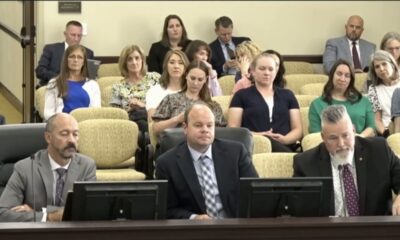

ASD slammed by Utah legislative committee for school closure process; board and superintendent subpoenaed for questioning
-
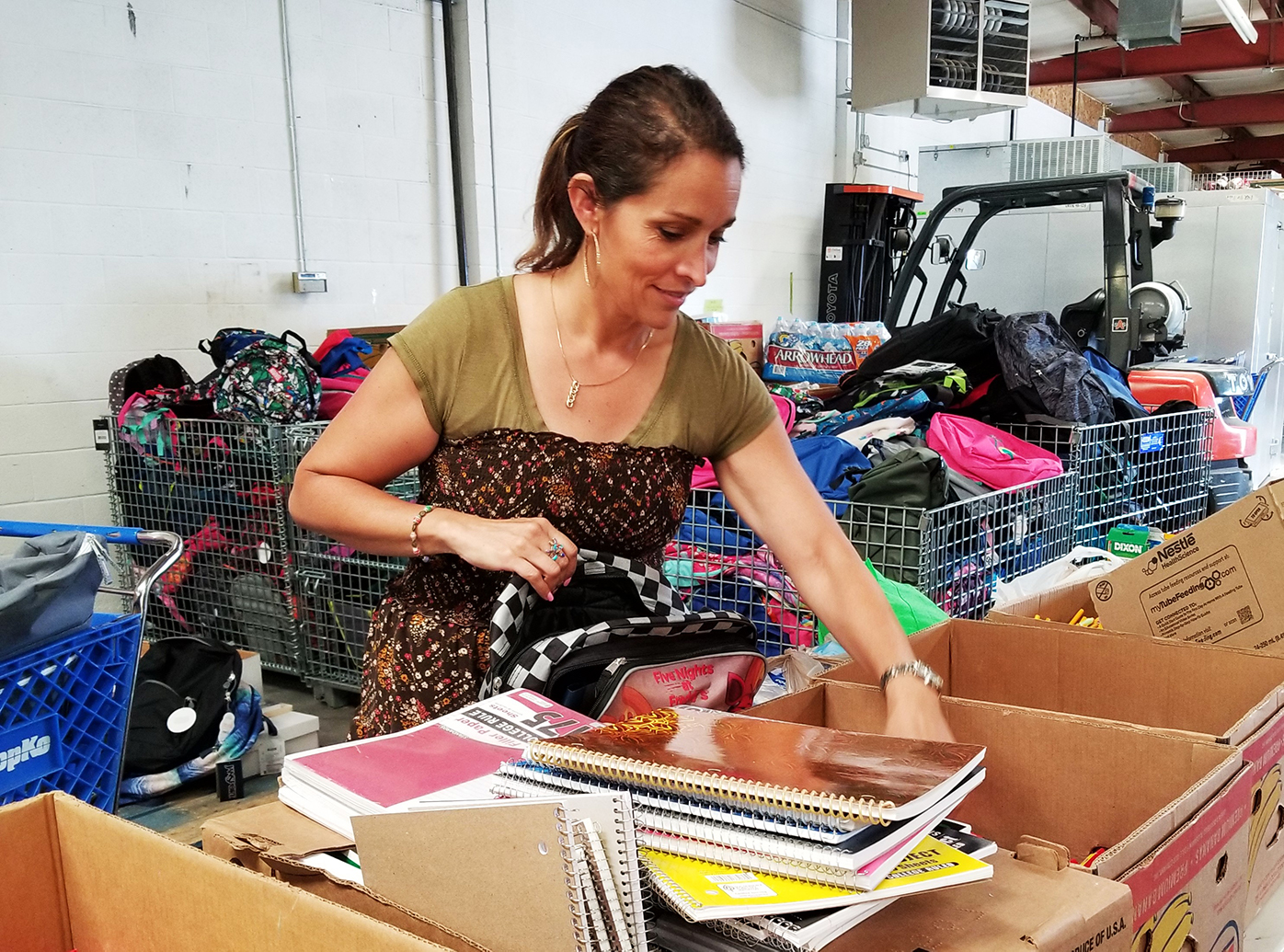

Local food pantry enlists neighbors in battle against hunger
-


Candidates for Lehi City Council Discuss Positions at Debate
-
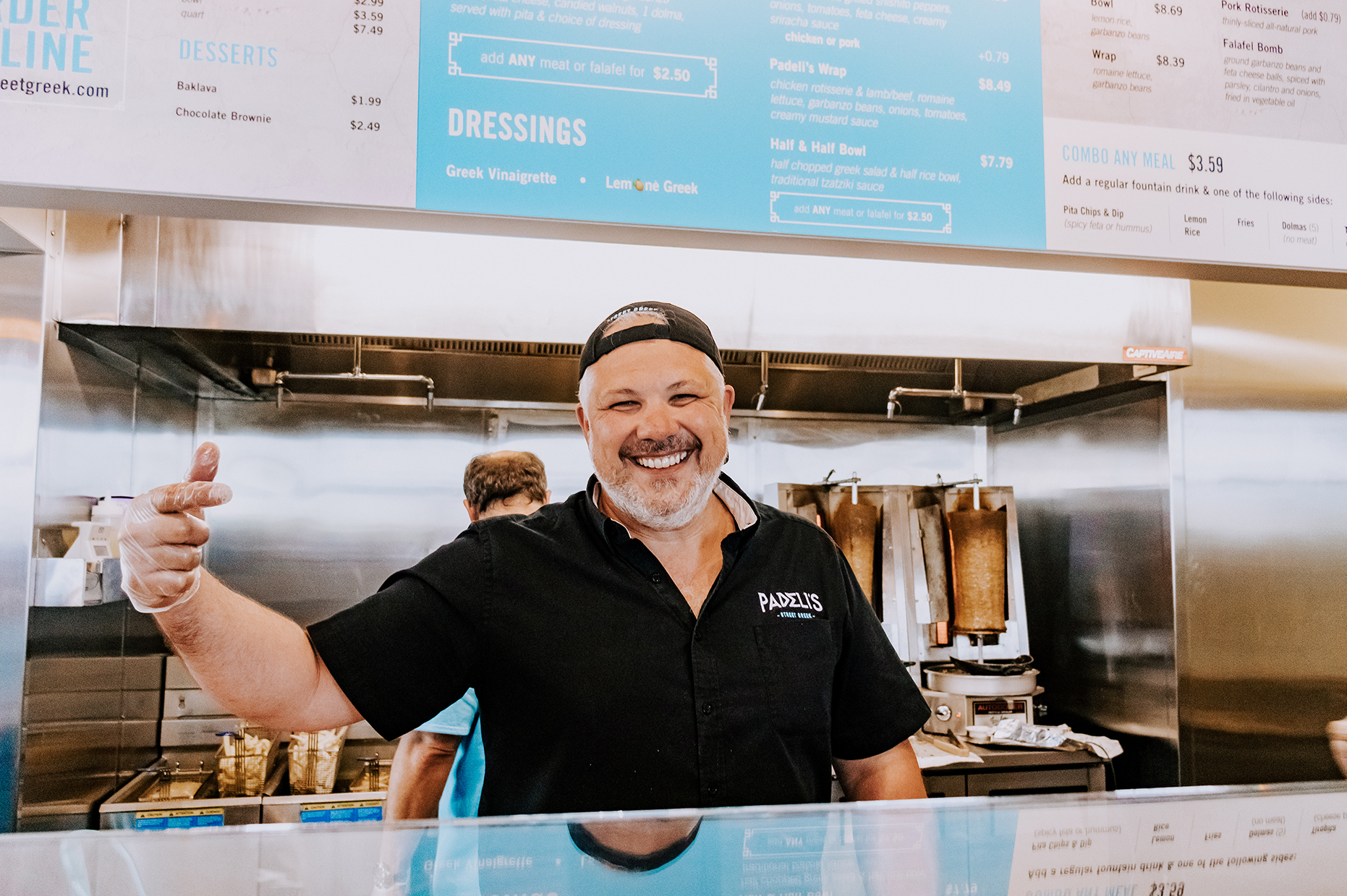

Restaurant review: Padeli’s Street Greek brings sensational Greek flavors to Lehi
-


LHS rebuild: What’s for lunch?
-


City Council approves revised Dixon Mink Farm, Ivory project
-


Skyridge Softball wins against Timp and Enterprise, Loses to Springville
-


ASD Accent on Excellence awards presented
-


Run for Your Mom 5K Saturday

